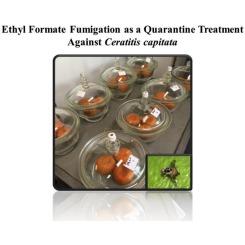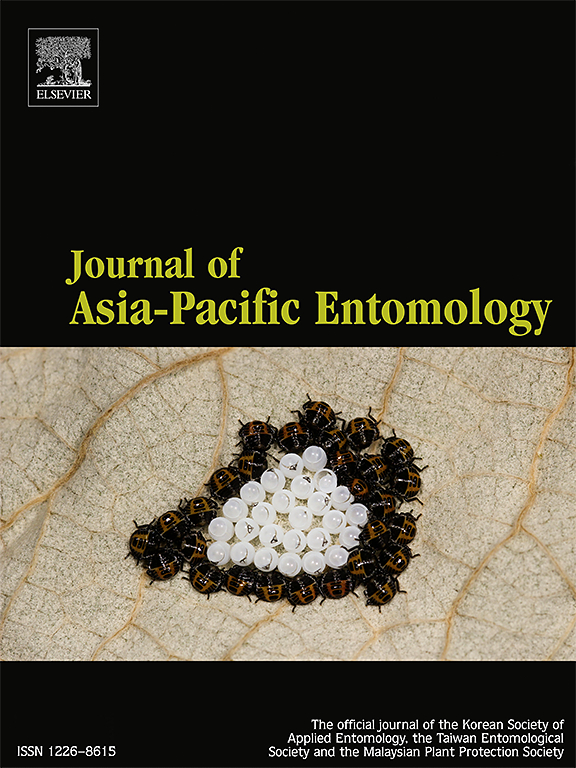Assessing the quarantine potential of ethyl formate as a stand-alone phytosanitary treatment against Ceratitis capitata: A comparative study on naked condition and natural infestation in mandarin
IF 1.3
3区 农林科学
Q3 ENTOMOLOGY
引用次数: 0
Abstract
The Mediterranean fruit fly, Ceratitis capitata (Wiedemann) (Diptera: Tephritidae), is a globally invasive pest that threatens biosecurity and agricultural trade due to its broad host range and high adaptability. Effective quarantine treatments are essential to prevent its introduction and establishment. This study evaluated the efficacy of ethyl formate (EF) fumigation as a phytosanitary treatment against C. capitata under two conditions: (1) naked condition and (2) natural infestation in mandarin. EF fumigation was conducted at 23 °C for 4 h, and mortality was obtained across different developmental stages. Under naked conditions, LCt99% values varied across developmental stages, with pupae showing the highest resistance (631.33 g h/m3) and adults the highest susceptibility (89.87 g h/m3) and eggs, 1st-2nd instar larvae and 3rd instar larvae were 406.86, 296.69 and 261.76 g h/m3, respectively. In naturally infested mandarins, significantly higher EF concentrations were required to achieve similar mortality levels, with LCt99% values for eggs and 1st-2nd instar larvae recorded at 745.18 g h/m3 and 642.42 g h/m3, respectively. These findings suggest that EF fumigation is more effective in direct exposure conditions, whereas the penetration limitations in citrus fruits necessitate higher dosages. This study provides critical data for establishing effective EF based quarantine treatments against C. capitata, contributing to the development of standardized phytosanitary treatment protocols.

评估甲酸乙酯作为单一植物检疫手段对头角虫的检疫潜力:柑桔裸染与自然侵染的比较研究
地中海果蝇(双翅目:绢蝇科)是一种全球性的入侵害虫,因其宿主范围广、适应性强,对生物安全和农业贸易构成威胁。有效的检疫措施对防止其传入和建立至关重要。研究了甲酸乙酯(EF)熏蒸在柑桔裸染和自然侵染两种条件下对头蚜的植物检疫处理效果。在23°C下进行EF熏蒸4小时,并获得不同发育阶段的死亡率。裸露条件下,不同发育阶段的LCt99%值存在差异,蛹的抗性最高(631.33 gh /m3),成虫的敏感性最高(89.87 gh /m3),卵、1 ~ 2龄幼虫和3龄幼虫的LCt99%值分别为406.86、296.69和261.76 gh /m3。在自然侵染的柑桔中,需要较高的EF浓度才能达到相似的死亡率水平,虫卵和1 ~ 2龄幼虫的LCt99%分别为745.18 gh /m3和642.42 gh /m3。这些发现表明,EF熏蒸在直接暴露条件下更有效,而柑橘类水果的渗透限制需要更高的剂量。本研究为建立有效的植物检疫处理方法提供了关键数据,有助于制定标准化的植物检疫处理方案。
本文章由计算机程序翻译,如有差异,请以英文原文为准。
求助全文
约1分钟内获得全文
求助全文
来源期刊

Journal of Asia-pacific Entomology
Agricultural and Biological Sciences-Insect Science
CiteScore
2.70
自引率
6.70%
发文量
152
审稿时长
69 days
期刊介绍:
The journal publishes original research papers, review articles and short communications in the basic and applied area concerning insects, mites or other arthropods and nematodes of economic importance in agriculture, forestry, industry, human and animal health, and natural resource and environment management, and is the official journal of the Korean Society of Applied Entomology and the Taiwan Entomological Society.
 求助内容:
求助内容: 应助结果提醒方式:
应助结果提醒方式:


